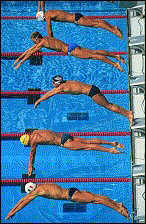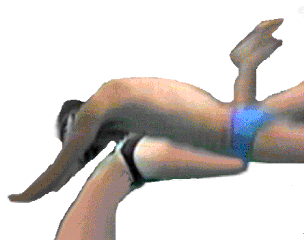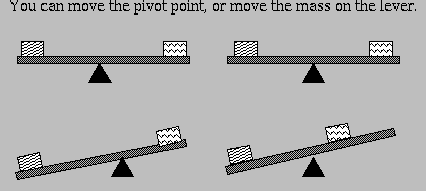

Post the News
Point of maximum height. Defining the angle of descent. Positioning the arms, head and toes.
We call this stage "posting the news" because the arms should be stretched out in front, leading the way as though the swimmer were going to stick a poster upon a imaginary wall in front of them.
The swimmers in the picture below have their arms in various posting positions but the best position is the arms reaching out in an attempt to lengthen the body and move the center of gravity farther out over the pool.


The legs should be fully extended and the feet should have left the platform. The hips will begin to pike upwards. The arms should be next to the ears and squeezed against the ears in streamline position as the hands are reaching out for the backstroke flags above.
The arms should extend out in front to lengthen the body so that the center of gravity is extended. Remember Sir Isaac Newton's "Action-reaction" Law being unavoidable. Many actions occur to balance other actions.
This is a very important skill to develop. If this skill is not learned the body will compensate with other adjustments in order for the body to start it's downward angle. When extending the center of gravity too far, a belly-flop may result. If the fulcrum is shortened, the legs will flip over the body.

The head should not be too high at this point. A high head will cause too flat a dive at entry, causing a belly flop or too much resistance from the entry of the legs by "ripping the hole back". The head should not be too low at this point either. A low head will cause too deep of a dive entry. If the head is too low, sometimes the legs will try to over-compensate by kicking the heels up against the buttocks in an attempt to shorten the center of gravity. When swimmers bring their knees up-close to their body, they are trying to adjust the center of gravity by shortening the fulcrum.
Many athletes will point their arms down to change the center of gravity. There is a better way, and that is by stretching out further in the streamline position while in the air. This is like extending the length of a teeter-totter.
The head should be in line with the spine at all times as the arms reach-out in an attempt to lengthen the body and lengthen the center of gravity.

The problem with shortening the fulcrum is that the dive entry will be too deep. It also causes a larger (rip or tear) hole in the surface of the water. The longer the tear or hole the more resistance which slows your momentum.

Some swimmers try shortening the fulcrum by bringing the legs up-close from the rear half of the body and pointing the arms down, as in the lower right diagram, above.
Extend the body with a high arcing dive. With the proper launch angle and body extension, you will gently rotate into the perfect entry position, without any position adjustments. The arms should be leading the way out in front as the head follows the leader and the body follows the head in preparing to enter through a single hole in the surface of the water.
Reach out with your hands as though you were going to grab the flags as you leap up and then out with your outstretched arms leading the way for the rest of the body to follow.